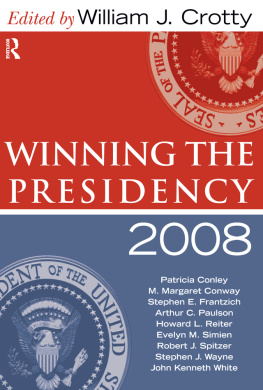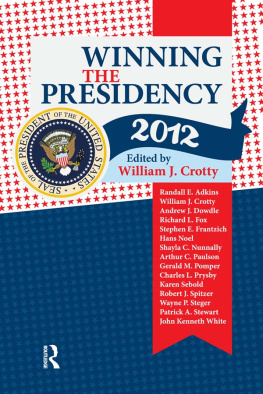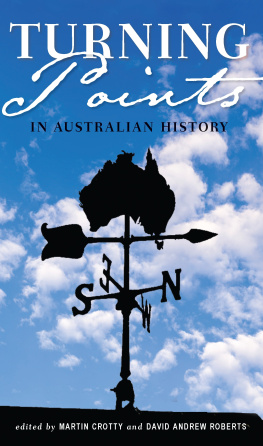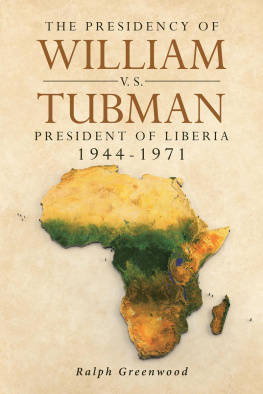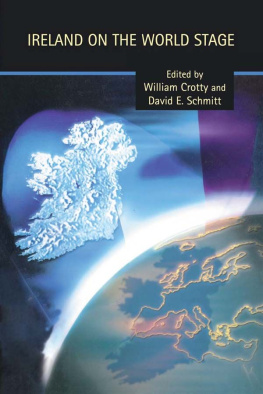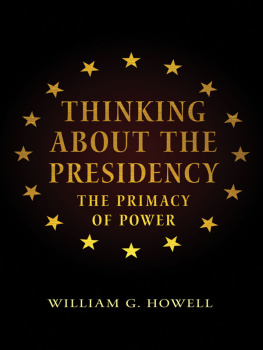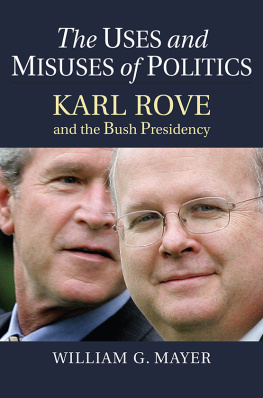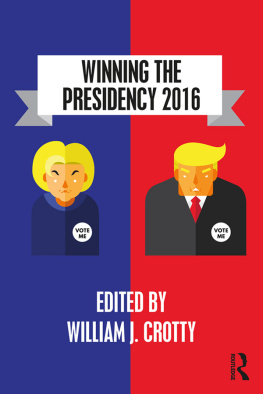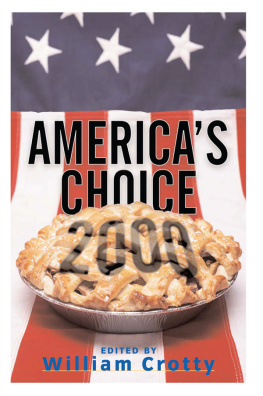Winning the Presidency 2008
Edited by
William J. Croty
First published 2009
by Paradigm Publishers
Published 2016
by Routledge
2 Park Square, Milton Park, Abingdon, Oxon OX14 4RN
711 Third Avenue, New York, NY 10017, USA
Routledge is an imprint of the Taylor & Francis Group, an informa business
Copyright 2009, Taylor & Francis.
All rights reserved. No part of this book may be reprinted or reproduced or utilised in any form or by any electronic, mechanical, or other means, now known or hereafter invented, including photocopying and recording, or in any information storage or retrieval system, without permission in writing from the publishers.
Notice:
Product or corporate name may be trademarks or registered trademarks, and are used only for identification and explanation without intent to infringe.
Library of Congress Cataloging-in-Publication Data
Winning the presidency 2008 / edited by William Crotty.
p. cm.
Includes bibliographical references and index.
ISBN 978-1-59451-590-3 (hardcover: alk. paper)
ISBN 978-1-59451-591-0 (pbk.: alk. paper)
1. PresidentsUnited StatesElection2008. 2.Political
campaignsUnited States. 3. United StatesPolitics and government
2001- I. Crotty, William J.
JK5262008 .W55 2009
324.973'0931dc22
2008055862
Design and composition by Cindy Young.
ISBN 13: 978-1-59451-590-3 (hbk)
ISBN 13: 978-1-59451-591-0 (pbk)
Contents
| William J. Crotty |
| William J. Crotty |
| Stephen J. Wayne |
| Howard L. Reiter |
| Arthur C. Paulson |
| M. Margaret Conway |
| Evelyn M. Simien |
| Stephen E. Frantzich |
| Robert J. Spitzer |
| Patricia Conley |
| John Kenneth White |
From the beginning, 2008 seemed to be destined for the history books. Whether looking to the legacy of two failed Bush administrations or the economic crisis on the near horizon, the issues confronting the candidates and, ultimately, the victor, were without parallel. Put those factors together with an election calendar whose start was so early and whose end came down to the election wire and you have a procedural challenge equal to the potential policy nightmare. Add candidates so unorthodox as to defy belief and voil2008 became the election of many lifetimes!
From a political science perspective, some of the most interesting facets of election 2008 are seemingly arcane. This book looks closely at the early part of the electoral cycle because it was so important in the eventual outcome. The changes in the rules that moved the primary elections up to the very beginning of 2008 were supposed to help settle the primaries early, but instead, they dragged on to just before the conventions, at least on the Democratic side. Caucus states became more important. Proportional allocation of delegates, along with the role of superdelegates and other representatives to the conventions, came into play as a result.
At the same time, larger political and societal forces were at work and drove the election. This book examines them closely, focusing on issues including the economic crisis, the innovative use of the Internet in mobilizing voters and fund-raising, and, of course, the candidates who embodied the dynamics not just of race and gender but also of religion and age in America past and present.
Before we look at the 2008 presidential campaign, its important to look at the state of the nation and the Bush administration to set the context. presents an overview of the election at large, and then the book digs into the nominating process. Stephen J. Wayne and Howard L. Reiter describe the intricacies of delegate selection, and Arthur C. Paulson brings to light the invisible primary that preceded this selection. Moving forward, M. Margaret Conway looks at the national conventions and the various stages of the general election campaign in terms of participation and turnout, and Evelyn M. Simien examines them in terms of race and gender. Stephen E. Frantzich explores the role of e-politics especially in fund-raising, and Robert J. Spitzer zeroes in on hot button issues past and present. The book concludes with a focus on election daythe outcome of the contest and its consequences. Patricia Conley explores the meaning of a mandate in the 2008 election, and John Kenneth White reflects on epoch-shifting trends in party politics, race and ethnic politics, and generational change.
As editor, I am indebted to a number of people. I would particularly like to thank Mallory Olin, Kristen Hudak, and Florencia Gabriele, all from the Center for the Study of Democracy at Northeastern University, for their considerable help.
Jennifer Knerr of Paradigm Publishers was a particularly knowledgeable and highly professional editor who was a pleasure to work with. Also at Paradigm Publishers I would like to acknowledge the considerable efforts of Jessica Priest and Melanie Stafford in bringing this book to publication.
To all, my thanks.
William Crotty
CHAPTER 1
The Bush Presidency and the 2008 Presidential Election
Context and Imprint
WILLIAM J. CROTTY
We need to be able to read the page before we turn it.
SENATOR PATRICK J. LEAHY calling for a truth commission to investigate the Bush administration
This chapter focuses on the factors leading up to the 2008 presidential election, those that combined to set the environment in which the presidential race would be fought. It serves as an introduction to the analyses to come in each of the following chapters and provides an overview and context for understanding the 2008 presidential race.
The Bush-Cheney Presidency: Setting an Agenda for the 2008 Race
The actions and policies of the Bush administration established, directly and indirectly, the agenda for the presidential campaign. The accomplishments, failures, and ambitions of the Bush administration were the baseline from which all else flowed. Given the controversial and historically pathbreaking actions of the administration in a number of areas, it constituted a level of significance that is difficult to summarize. The issues generated by the Bush-Cheney years raised questions about the nations constitutional design as well as the wars in progress, the relevance of established legal procedures, and, most markedly for the 2008 race, an economy in deep trouble. How such concerns were to be addressed and their impact on the presidential contest and its outcome are questions at the heart of the 2008 presidential contest.
With this as prelude we turn to a discussion of governancepolicy, administration, and law during the Bush-Cheney years. The canvas is exceptionally broadacademicians, legal analysts, foreign and domestic policy experts, and the courts will be debating and dealing with the issues raised as well as their budgetary and social consequences and Americas relations with the international community for decades and generations to come. The Bush presidency was in a very real sense a transitional presidency, one that set an agenda for the 2008 campaign and one the incoming Obama administration must address in its many multilayered facets.



